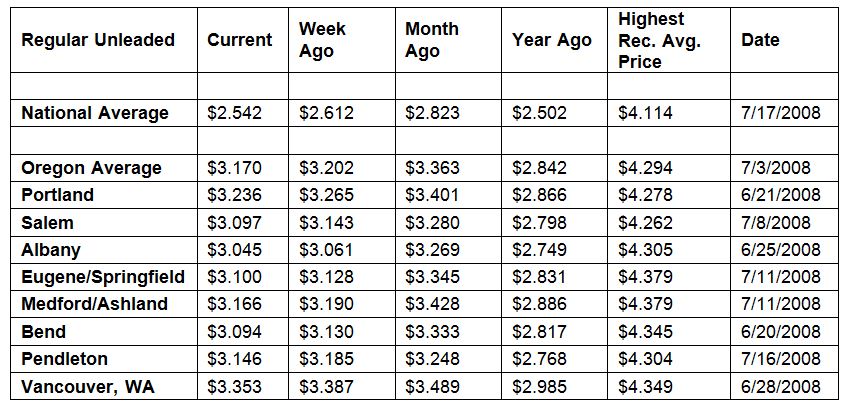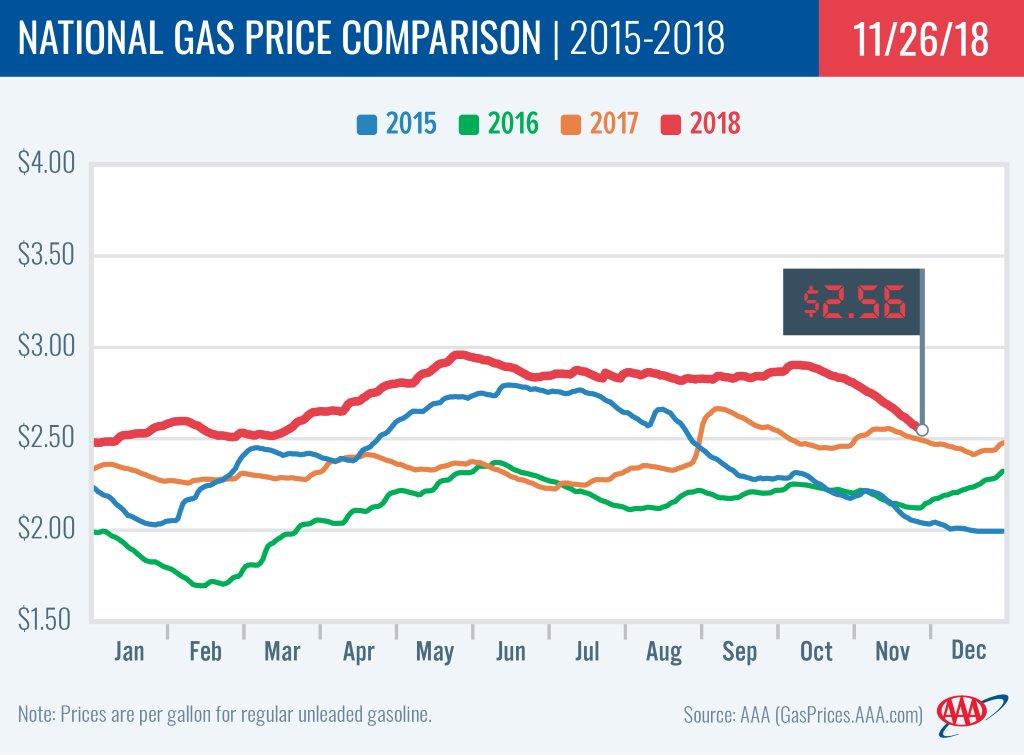PORTLAND, Ore., – Retail gas prices are steadily declining as crude oil prices plunged to their lowest level in over a year. For the week, the national average for regular loses seven cents to $2.54 while Oregon’s average drops three cents to $3.17. The national average is at its lowest price since March while the Oregon average is at its lowest price since April.
U.S. demand for gas remains low, supplies are plentiful and crude oil prices tumbled to their lowest prices since October 2017 last week after reports of rising inventories. “December may bring some of the cheapest gas prices of the year if current trends continue,” says Marie Dodds, public affairs director for AAA Oregon/Idaho. The national and Oregon averages were at their lowest year-to-date prices last January 1 when the national average was $2.49 and the Oregon average was $2.79.
Gas Prices are lower week-over-week in all 50 states and the District of Colombia. Ohio has the largest weekly decrease (-14 cents). Wyoming has the smallest weekly decrease (-2 cents). This week six states have averages at or above $3 a gallon, down from seven a week ago.
Pump prices are lower than a month ago in every state and the District of Colombia. The national average is 28 cents less and the Oregon average is 19 cents less than a month ago. Michigan has the largest monthly decrease (-42 cents). Wyoming has the smallest monthly decrease (-7 cents).
The West Coast continues to have the most expensive gas prices in the nation. Hawaii tops the list for the 25th week in a row with California, Washington, Alaska, Nevada, Oregon and Idaho rounding out the top seven. Oregon is sixth most expensive for the second week in a row. On the week, Hawaii has the largest drop in the region, down eight cents.
The U.S. Energy Information Administration’s (EIA) weekly petroleum status report for the week ending on November 16 shows West Coast gasoline stocks increased by 300,000 bbl to 26.9 million bbl. Stocks are approximately 1.3 million bbl lower than at this time last year, which could cause prices to spike if there is a supply challenge in the region this week.
The nation’s cheapest markets are Missouri ($2.17) and Oklahoma ($2.21) and. For the 69th week in a row, no states have an average below $2.
Oregon is one of 30 states and the District of Columbia where drivers are paying more than a year ago to fill up. The national average is four cents more and the Oregon average is 33 cents more than a year ago. This is the eighth-largest yearly increase in the country. Hawaii (+50 cents) has the greatest year-over-year increase; Nevada (+47 cents) is second; Arizona (+44 cents) is third; Utah (+42 cents) is fourth; and California (+41 cents) is fifth.
Oil Market Dynamics
Crude oil prices plunged last week to their lowest levels since October 2017 as the EIA reported that crude inventories continue to build. The latest EIA weekly petroleum report showed that crude inventories grew by 4.9 million bbl to 447 million bbl. Total domestic crude inventories have grown for nine consecutive weeks. If this week’s EIA report shows another build, crude prices will likely continue their descent.
Growth in global crude production, including in the U.S., combined with weaker than expected global crude demand for the fourth quarter of 2018 have contributed to growth in global crude inventories. Market observers will now watch OPEC closely, which may decide to reduce its total crude production by 1 million to 1.4 million barrels per day at its meeting on December 6 in Vienna, Austria. If OPEC and Russia decide to reduce production, crude prices will likely increase due to reduced global supply as a result of the agreement.
At the close of Friday’s formal trading session on the NYMEX, West Texas Intermediate dropped $4.21 and settled at $50.42. At the close of Monday’s formal trading session on the NYMEX, WTI added $1.21 to settle at $51.63. Today crude is trading around $51, compared to $54 a week ago. Crude prices are down about 23 percent in the last month and are about $7 per barrel lower than a year ago.
Drivers can find current gas prices along their route with the free AAA Mobile app for iPhone, iPad and Android. The app can also be used to map a route, find discounts, book a hotel and access AAA roadside assistance. Learn more at AAA.com/mobile.
Diesel
For the week, the national average falls three cents to $3.19 a gallon. Oregon’s average dips two cents to $3.37. A year ago the national average for diesel was $2.84 and the Oregon average was $3.03.
Find current fuel prices at GasPrices.AAA.com.
AAA news releases, high resolution images, broadcast-quality video, fact sheets and podcasts are available on the AAA NewsRoom at NewsRoom.AAA.com.



